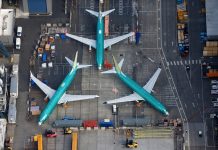
Boeing announced its plans to reduce aircraft production plans and slash jobs as the coronavirus pandemic devastates air travel.
Boeing’s airline customers have grappled with financial losses due to the pandemic, diminishing the demand for new planes. Boeing was reportedly facing a crisis before the coronavirus took place because of the fallout from two deadly crashes of its 737 Max that led to the death of 346 lives.
Boeing previously disclosed its plan to cut of 10% of its 160,000-person workforce due to weaker demand. Letting go of employees will be made through buyout packages and involuntary cuts.
“Regretfully, the prolonged impact of COVID-19 causing further reductions in our production rates and lower demand for commercial services means we’ll have to further assess the size of our workforce,” CEO Dave Calhoun said in a staff note after the company announced its $2.4 billion quarterly loss.
“This is difficult news, and I know it adds uncertainty during an already challenging time. We will try to limit the impact on our people as much as possible going forward,” he said.
Boeing's revenue
Based on average analysts estimates from Refinitiv, this was how Boeing performed compared with Wall Street predictions:
• Losses per share: $4.79 a share, adjusted, vs $2.54 expected
• Revenue: $11.8 billion vs $13.16 billion expected
Boeing’s second-quarter results surfaced worse than analysts expected. Revenue dropped 25% to $11.81 billion from $15.75 billion a year earlier and less than analysts’ forecasts for sales of $13.16 billion. The commercial aircraft unit fell the hardest with a 65% drop in revenue from a year earlier to $1.6 billion as deliveries of new planes declined.
Boeing’s defense unit showed more resilience than its commercial business, collecting $6.6 billion, roughly flat on the year.
For the quarter ended June 30, Boeing’s net loss was down to $2.40 billion, or $4.20 per share, from $2.94 billion, or $5.21 per share, a year earlier, when it presented a nearly $5 billion charge on its 737 Max program.
Boeing lost $4.79 per share on an adjusted basis, compared with a $2.54 per-share loss Wall Street predicted. Boeing saw its shares increase by 1.2% in premarket trading.
Boeing also mentioned its plans to reduce its planned ramp-up of production. It would slowly expand manufacturing of its 737 Max to 31 a month by the beginning of 2022, later than it had predicted. It will again slash production of its 787 planes to six a month next year.
Decline in production
Moreover, the company said it would cut production of the 747, a plane it has manufactured for more than five decades and is lauded for strengthening travel worldwide, in 2022.
According to consulting firm Ascend by Cirium, Boeing owns more than 470 planes on the ground that have not been delivered to customers, most of them 737 Max jets.
Airbus, Boeing’s main rival, is also affected by the coronavirus crisis and is expected to present results on Thursday.
Calhoun previously said that recovery in air travel demand will likely take two or three years. International demand has remained soft, affecting the outlook for Boeing’s widebody commercial planes, like the 787 Dreamliner.
Meanwhile, the International Air Transport Association said that passenger air travel demand globally may recover to 2019 levels in 2024, a year later than it previously predicted.






